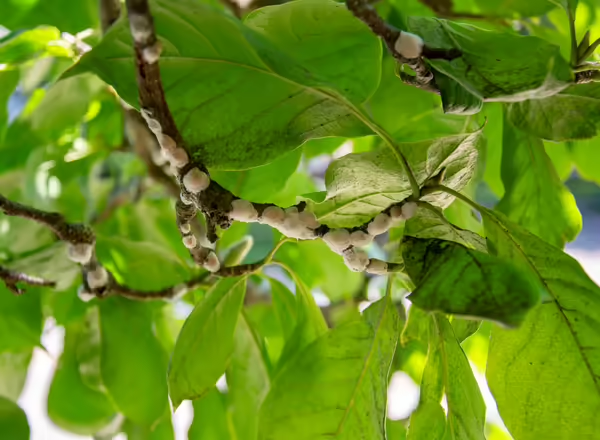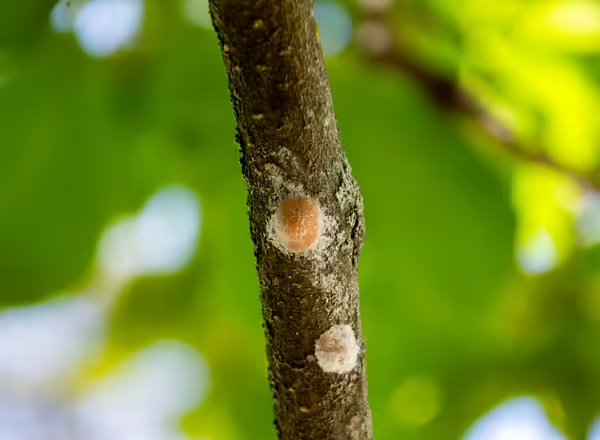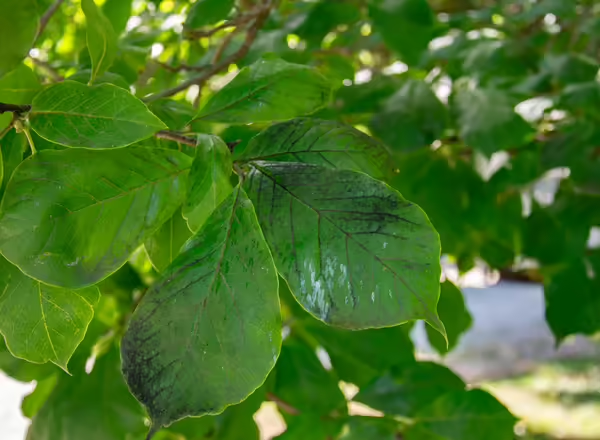
Magnolias are popular trees and shrubs in many landscapes. Their large, showy flowers can range from white to pink to yellow and provide a burst of color in the spring. While they are relatively pest-free, one of the biggest pests is the magnolia scale (Neolecanium cornuparvum), which appears to be on the rise in many places in Illinois.
Magnolia scale is native to and can be found throughout the eastern United States. While they don’t always cause problems, occasionally outbreaks can occur, and populations can get high enough to weaken or even kill trees.
What does magnolia scale look like, and life cycle
Magnolia scale overwinters as dark-colored nymphs on one- to two-year-old branches of magnolias. As temperatures warm in the spring, the nymphs will begin feeding on plant sap, usually around the time leaves begin to emerge. They will grow quickly and will appear as oval bumps on twigs and branches. Their bodies can vary in color from pinkish to purple to brown and are covered in a white, powdery, waxy substance.
The male magnolia scale will mature before females do. They are not as large and resemble gnats. The males will mate with immature females and then die. Females will continue to feed and grow and will mature in mid to late summer. When female magnolia scales are mature, they can be up to ½ long, making them the largest scale insect found in the United States. They will also lose their waxy coating and will have a helmet-shaped appearance.
Mature females will give birth to live young (vivipary), called crawlers, from late summer to early fall. The crawlers are small (1/25 inch), flat, and oval and can vary in color from yellow to reddish-brown. They are the only life stage that is mobile and will search for a place to feed. Once they have found a suitable site, usually newer growth, they will begin to feed and spend the rest of their lives in that spot.



Damage caused by magnolia scale
Magnolia scale will feed on the sap of plants. When populations become large, this feeding can weaken trees, which can lead to reduced growth and leave size as well as yellowing of leaves. Branches that are heavily infested can be killed, and, in extreme cases, plants can be killed.
In addition to feeding on sap, magnolia scale will also produce large amounts of honeydew, a clear, sticky liquid full of sugars, which will cover the plants and anything beneath them. A fungus known as sooty mold will grow on the honeydew and can cause objects to become unsightly. While it is primarily a nuisance, in rare occurrences, sooty mold growth can become so extensive it interferes with photosynthesis by blocking light from the leaves.
Non-native magnolia species and hybrids such as star (Magnolia stelleta), saucer (Magnolia x soulangiana), and lily (M. liliiflora) are most susceptible to magnolia scale. Native species like cucumber tree magnolia (M. acuminata) may be attacked but are more resistant and are rarely damaged, and some, like sweetbay magnolia (M. virginiana) are rarely attacked.
Managing magnolia scale
If you have magnolias in your landscape, particularly non-native species or hybrids, periodically inspect your plants for the presence of magnolia scale. As with all pests, the sooner you notice them the easier it is to manage them. Fortunately, there are several ways magnolia scale can be managed:
Physically remove them
If the infestation is small and you can reach them, they can be removed by hand or by using a soft-bristled scrub brush (make sure you don’t damage the bark of the plant). This should be done as soon as you notice the scale and before crawlers emerge.
Heavily infested branches can be pruned out. Before you remove a branch, make sure it won't disfigure the plant, and make sure you are using proper pruning techniques.
Natural enemies
Several different kinds of insects, like lady beetles, lacewings, and parasitoid wasps, will feed on magnolia scale. However, they often can’t keep up when populations get large, and may not be a reliable management tool, especially on susceptible magnolias.
Insecticides
Insecticides are the most common way to manage magnolia scale, but timing is important. The crawlers are the most susceptible stage to insecticides. Contact insecticides can be used in late summer or early fall to manage crawlers. More than one application will often be needed. Because of their size, it may be best to have a professional treat large trees.
Dormant oil sprays can also be used in early spring, before buds begin to break. These oils will suffocate the nymphs, so good coverage is essential (if the oil doesn’t get on the nymph, it won’t work).
Systemic insecticides can also be used. Research done in Ohio found that applying imidacloprid to plants in early May provided excellent control of magnolia scale. These products are applied to the soil and will be taken up and moved throughout the plant.
If you choose to apply insecticides to manage magnolia scale, regardless of what you use and when you apply it, make sure to read and follow all label directions.
Good Growing Fact of the Week: Ants will often feed on honeydew produced by soft scales, like magnolia scale, and will defend them from potential predators. Research done in Kentucky found that if ants are excluded from magnolia trees there was an 82% reduction in the number of adult magnolia scales on those trees.
Resources and for more information
Herms DA, Nielsen DG (2004) The magnolia scale: biology and management of a key pest of magnolia.Ohio Agric Res Dev Cntr Circ 193:74–77. https://kb.osu.edu/items/ccda84fc-f78b-5ff4-9430-07b14a0dc42d
Knox, Gary W, William E Klingeman, Mathews L Paret, and Amy F Fulcher. 2012. Review of Magnolia - Magnolia spp. In IPM for Select Deciduous Trees in Southeastern US Nursery Production, edited by Amy Fulcher and Sarah White, 181–210. Knoxville, TN: Southern Nursery IPM Working Group. https://wiki.bugwood.org/IPM_book.
Vanek, Sarah J, and Daniel A Potter. 2010. “Ant-Exclusion to Promote Biological Control of Soft Scales (Hemiptera: Coccidae) on Woody Landscape Plants” 39 (6): 1829–37. https://doi.org/10.1603/en10093.
Photos by Ken Johnson, University of Illinois Extension
Want to get notified when new Good Growing posts are available? SIGN ME UP!
Give us feedback! How helpful was this information (click one): Very helpful | Somewhat helpful | Not very helpful
MEET THE AUTHOR
Ken Johnson is a Horticulture Educator with University of Illinois Extension, serving Calhoun, Cass, Greene, Morgan, and Scott counties since 2013. Ken provides horticulture programming with an emphasis on fruit and vegetable production, pest management, and beneficial insects. Through his programming, he aims to increase backyard food production and foster a greater appreciation of insects